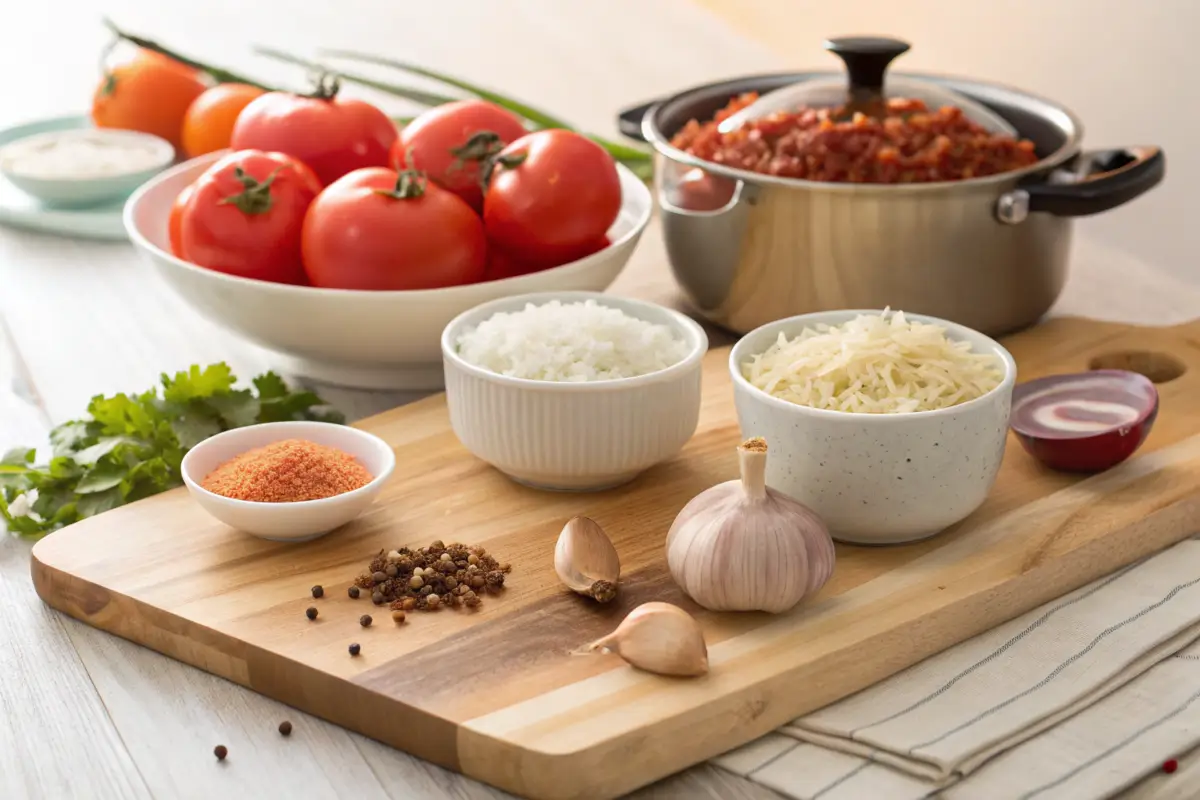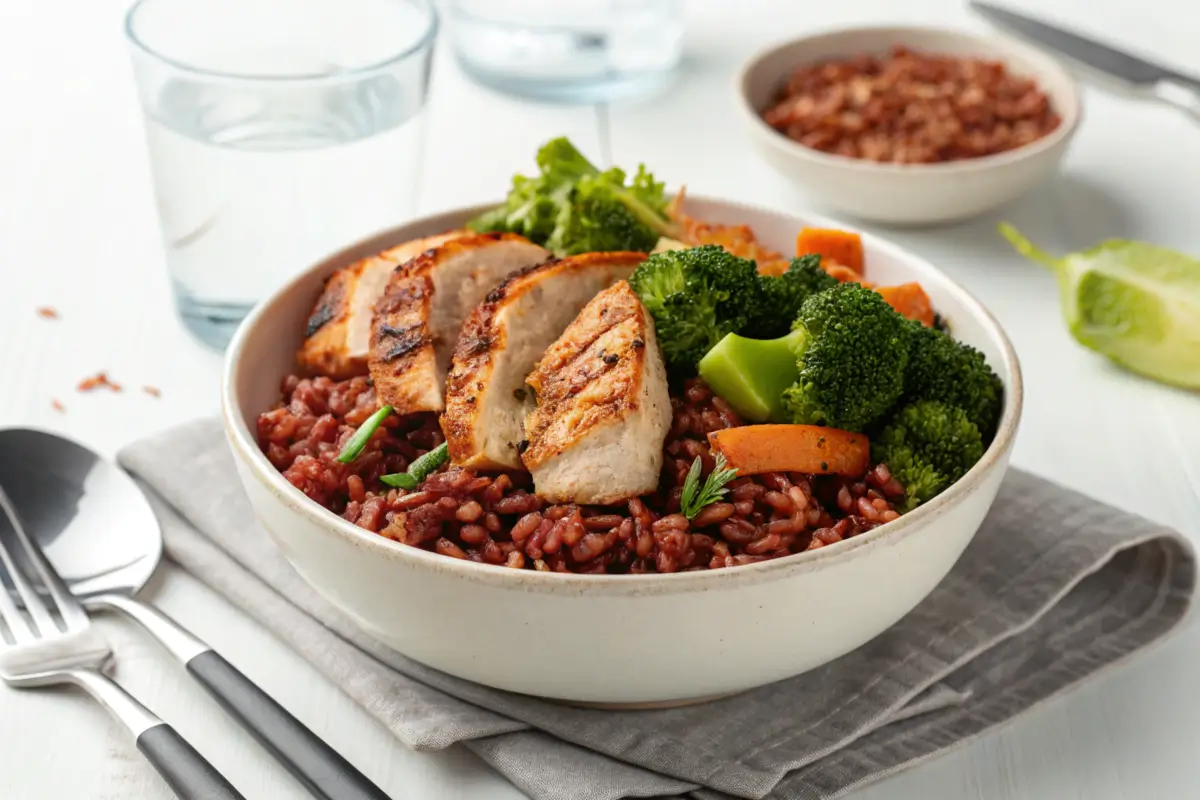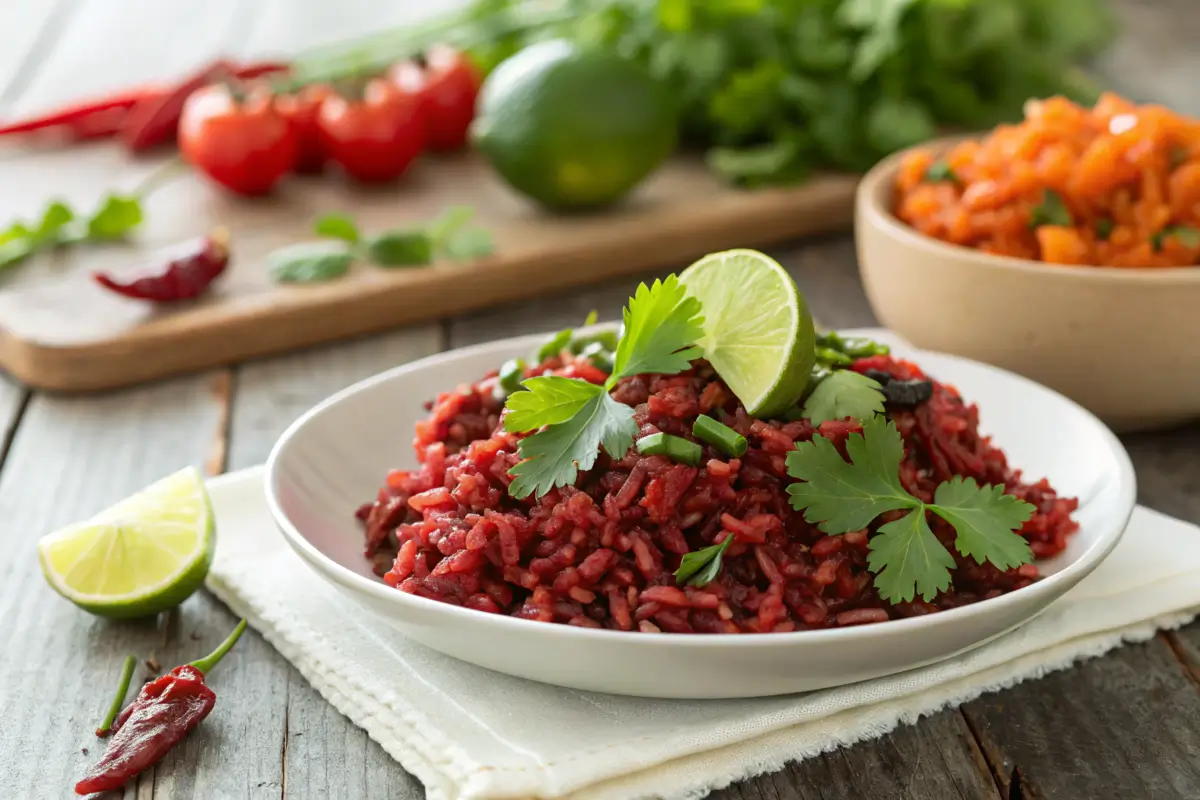Red rice is a delicious and versatile dish, enjoyed in cuisines worldwide. Whether you’re looking for a traditional red rice recipe like Mexican Arroz Rojo or experimenting with healthy rice alternatives, this guide has you covered. Packed with flavor and nutrients, red rice is perfect for creating satisfying meals that pair well with a variety of proteins and vegetables. Let’s dive into the ultimate guide to making fluffy, flavorful red rice every time!
Introduction to Red Rice
What is Red Rice?
Red rice is a rice variety or dish where the grains or ingredients take on a reddish hue due to natural pigments or seasonings like tomatoes, paprika, or chili. This vibrant dish is not just about looks—it’s loaded with rich, savory flavors that make it a favorite at dinner tables worldwide. Whether it’s Mexican Arroz Rojo or a South Asian delicacy, red rice stands out as a crowd-pleaser.
History and Cultural Significance
The roots of red rice can be traced back to regions that treasure both its flavor and versatility. In Mexican cuisine, Arroz Rojo (red rice) is a quintessential side dish served with beans, tacos, and enchiladas. South Asian cultures also prize red rice, not only for its nutty taste but also for its health benefits. Historically, red rice has symbolized prosperity and abundance, often featured in celebratory meals and feasts.
Why Red Rice Stands Out in Recipes
So, what makes red rice a go-to dish? It’s all about the perfect balance of flavors and textures. A well-prepared red rice dish is fluffy yet firm, with a savory tomato base complemented by aromatic spices. Moreover, it pairs beautifully with a variety of proteins and vegetables, making it a versatile and healthy choice for any meal.
Types of Red Rice and Their Unique Qualities
Traditional Mexican Red Rice (Arroz Rojo)
Mexican Arroz Rojo is a beloved classic that showcases red rice’s versatility. Often made with long-grain rice, this dish gets its signature hue and taste from a blend of tomatoes, garlic, onions, and spices. The key to nailing this recipe is the perfect rice-to-liquid ratio, ensuring a fluffy and flavorful outcome. Paired with proteins like enchiladas or carne asada, it becomes a staple of Mexican cuisine.
For a deeper dive into related dishes, check out the Boulders Enchilada Recipe for inspiration on complementary meals.
South Asian Red Rice Varieties
South Asia embraces red rice as a nutrient-rich alternative to white rice. Packed with fiber, iron, and antioxidants, these varieties include hand-pounded and unpolished grains that retain their reddish outer layer. Used in dishes like red rice pilafs and biryanis, this rice adds a nutty flavor and chewy texture that complements robust curries and stews.
Health Benefits of Red Rice
Red rice isn’t just delicious; it’s a nutritional powerhouse. Rich in anthocyanins, it boasts anti-inflammatory and antioxidant properties. Its higher fiber content helps with digestion and keeps you feeling full longer. Compared to white rice, it also has a lower glycemic index, making it ideal for those managing blood sugar levels.
Ingredients and Preparation Techniques
Essential Ingredients for Red Rice
To create the perfect red rice recipe, you’ll need a few staples: rice, tomato paste or puree, broth, onions, garlic, and spices. For added flair, consider fresh herbs like cilantro or parsley. Variations might include vegetables like peas and carrots or proteins like chorizo and shrimp for heartier versions.
The Art of Choosing the Right Rice
Not all rice varieties are created equal when it comes to red rice. For fluffiness, long-grain rice like jasmine or basmati works wonders. If you’re leaning towards a chewy texture, opt for unpolished or South Asian red rice. The choice of rice can make or break your dish’s consistency and flavor.
Cooking Broths and Flavors to Enhance Your Red Rice
The secret to a mouthwatering red rice dish lies in the broth. Using chicken, beef, or vegetable broth instead of water amplifies the taste. Adding aromatics like garlic, onions, and peppers during cooking infuses layers of flavor. Don’t forget a pinch of salt and spices like cumin or paprika for extra depth.
By incorporating the tips above, you can elevate your red rice recipe from good to unforgettable.
Step-by-Step Recipe for Classic Red Rice
Preparing the Base: Onions, Garlic, and Tomatoes
The base of a great red rice recipe starts with fragrant ingredients like onions and garlic. Begin by heating a tablespoon of oil in a large pan over medium heat. Add finely chopped onions and minced garlic, stirring until they become translucent and aromatic. The next step is incorporating tomato paste or puree, which gives the rice its beautiful red hue and tangy flavor.
For an exciting variation, consider adding a dash of paprika or cumin to the base to deepen the flavor profile. This simple foundation is key to a delicious dish that pairs well with a variety of sides.

Cooking the Rice: Techniques for Perfect Texture
Achieving fluffy and flavorful red rice comes down to technique. Once the base is ready, mix in your uncooked long-grain rice. Stir it well to coat each grain with the tomato mixture. Then, pour in hot chicken or vegetable broth, maintaining a 2:1 liquid-to-rice ratio.
Cover the pan with a tight-fitting lid, reduce the heat to low, and let the rice simmer for about 15-20 minutes. Avoid lifting the lid, as the trapped steam is essential for even cooking. Once the liquid is absorbed, let the rice rest for another 10 minutes before fluffing it with a fork.
Serving Suggestions and Variations
Serve your classic red rice alongside grilled chicken, beans, or sautéed vegetables. For added flair, sprinkle fresh cilantro or parsley on top before serving. Looking for more ideas? Incorporate peas, diced carrots, or even shrimp to transform this side dish into a satisfying main course.
Red Rice Recipes Around the World
Mexican-Inspired Red Rice
Mexican Arroz Rojo is perhaps the most well-known variation of red rice. Made with long-grain rice, tomatoes, onions, garlic, and flavorful broth, it’s the perfect side for tacos, enchiladas, or grilled meats. Some recipes include a whole jalapeño for a subtle spicy kick.
For a great pairing, check out this recipe for Boulders Enchiladas to complete your meal.
Indian Red Rice Pilaf
In India, red rice is often used in pilaf recipes that combine bold spices like turmeric, cumin, and cardamom. These recipes frequently feature nuts, raisins, and vegetables, making them a delicious and colorful centerpiece for any table. Red rice pilaf is a favorite for festive occasions due to its rich taste and health benefits.
Fusion Recipes to Try
Red rice lends itself well to fusion dishes, blending global flavors in exciting ways. Try a red rice bowl with teriyaki chicken, avocado, and sesame seeds for an Asian twist. Or, create a Mediterranean-inspired dish with roasted vegetables, feta cheese, and olive oil.
FAQs About Red Rice Recipes
What Makes Red Rice Different from Other Rice Varieties?
Red rice stands out for its vibrant color and distinct flavor. Unlike white rice, which is polished to remove the bran layer, red rice retains its outer layer, giving it a slightly nutty taste and chewy texture. Additionally, many red rice recipe variations, such as Mexican Arroz Rojo, rely on tomatoes or spices to achieve their signature hue.
Can I Use Red Rice in Other Dishes?
Absolutely! Red rice is incredibly versatile. You can substitute it in recipes that call for white or brown rice to add more flavor and nutrition. From fried rice to hearty grain bowls, the possibilities are endless. For instance, a red rice stir-fry with vegetables and soy sauce makes a quick and healthy meal.
How Do I Store Leftover Red Rice?
To store leftovers, allow the rice to cool completely before transferring it to an airtight container. Refrigerated red rice lasts up to four days, and you can freeze it for up to three months. When reheating, sprinkle a little water to restore moisture and fluff the rice with a fork.
Nutritional Insights and Health Benefits of Red Rice
Nutritional Breakdown of Red Rice
Red rice is packed with nutrients that make it a healthier choice than white rice. It contains more fiber, which aids digestion, and is rich in antioxidants like anthocyanins, known for their anti-inflammatory properties. With higher levels of iron and magnesium, red rice supports energy production and bone health.
Why Red Rice is a Great Alternative to White Rice
One of the main reasons to choose red rice is its low glycemic index, which helps regulate blood sugar levels. This makes it an excellent option for people with diabetes or those looking to manage their weight. Plus, its rich, nutty flavor adds depth to any dish, making it a delightful alternative to bland white rice.
Incorporating Red Rice into a Balanced Diet
Adding red rice to your meals is simple and rewarding. Use it as a base for grain bowls, mix it into soups, or pair it with grilled vegetables for a wholesome side. For a complete meal, try a red rice pilaf with lean protein like chicken or tofu.
By integrating red rice into your diet, you not only enjoy a delicious ingredient but also benefit from its impressive nutritional profile.
Common Mistakes and How to Avoid Them
Overcooking or Undercooking Rice
One of the most common challenges with a red rice recipe is getting the texture just right. Overcooked rice becomes mushy, while undercooked rice can feel crunchy. To avoid this, always use the correct liquid-to-rice ratio (typically 2:1 for most recipes) and simmer the rice over low heat. Resist the urge to lift the lid while it cooks, as this releases essential steam.
Using Incorrect Ratios of Liquid to Rice
Too much or too little liquid can make or break your red rice. A soupy dish or one with undercooked grains often results from incorrect measurements. Use a measuring cup for precision and adjust the liquid based on the type of rice you’re using. For example, brown or red rice may require a bit more liquid and a longer cooking time.
Overusing Tomato Paste or Spices
It’s easy to go overboard with tomato paste or spices, which can overwhelm the natural flavors of the rice. Stick to a balanced amount, typically 2-3 tablespoons of tomato paste per cup of rice. Taste your dish before serving to ensure the flavors are harmonious, and adjust the seasoning if needed.
Popular Pairings with Red Rice

Protein Pairings: Meat, Fish, and Vegetarian Options
A red rice recipe shines brightest when paired with the right proteins. Try serving it alongside grilled chicken, roasted fish, or shrimp for a classic combination. Vegetarian options like spiced chickpeas or sautéed tofu also complement red rice beautifully, creating a balanced and satisfying meal.
Side Dishes to Complement Red Rice
Red rice pairs exceptionally well with a variety of side dishes. Beans, whether refried or black, enhance the meal’s heartiness. Fresh salads, such as a tangy cucumber or tomato mix, add a refreshing contrast. For a more indulgent touch, creamy avocado slices or a dollop of sour cream elevate the dish.
Using Red Rice in Main Dishes Like Burritos or Bowls
Red rice is versatile enough to star in main dishes like burritos or grain bowls. Layer it with beans, vegetables, cheese, and your favorite sauce for a customizable meal. For a Mediterranean twist, top it with roasted vegetables, feta cheese, and a drizzle of olive oil.
Conclusion and Expert Tips for Perfect Red Rice
Final Thoughts on Red Rice Recipes
Red rice is more than just a side dish—it’s a flavorful and nutritious foundation for countless meals. Whether you’re preparing a traditional Mexican red rice recipe or experimenting with fusion cuisines, this dish is as versatile as it is delicious. By mastering the basics and exploring creative variations, you can turn red rice into the star of your table.
Expert Tips for Consistently Great Results
- Choose Quality Ingredients: Use fresh tomatoes, high-quality broth, and aromatic spices to build a robust flavor base.
- Stick to the Ratios: Maintaining the correct rice-to-liquid ratio ensures your red rice is fluffy and perfectly cooked every time.
- Don’t Skip Resting: Allowing the rice to rest after cooking helps absorb any remaining liquid and improves its texture.
- Experiment with Add-ins: Enhance your red rice recipe with extras like vegetables, proteins, or fresh herbs for added flavor and nutrition.
- Taste as You Go: Adjust the seasoning during the cooking process to balance flavors.
Red rice offers endless possibilities for creative and delicious meals. By following these expert tips, you’ll be able to prepare a dish that is both impressive and satisfying. Ready to serve your best red rice yet? Dive into your kitchen and enjoy the process!

